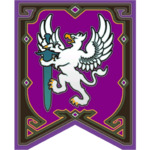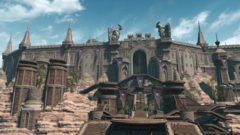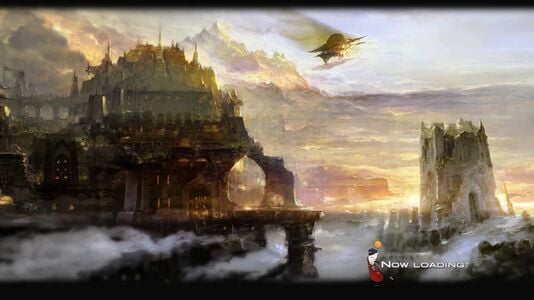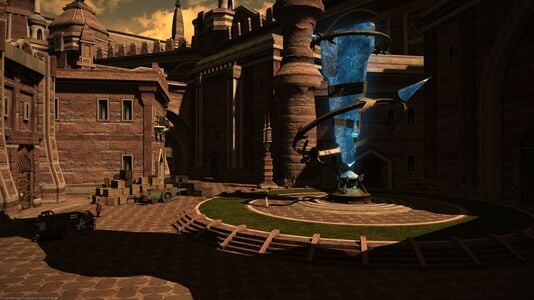Ala Mhigo
 This article is about the city state as a whole. For the level 70 Dungeon, see Ala Mhigo (Duty). For the settlement in Thanalan, see Little Ala Mhigo.
This article is about the city state as a whole. For the level 70 Dungeon, see Ala Mhigo (Duty). For the settlement in Thanalan, see Little Ala Mhigo.
Ala Mhigo
- Type
- City
- Zone
- Gyr Abania
(Aldenard) - Aetherytes
- The Ala Mhigan Quarter (X:33.6, Y:34.0)
“At the culmination of a bloody war, the city-state of Ala Mhigo at last won its freedom from two decades of stifling imperial rule. The nation has entered the ranks of the Eorzean Alliance, and now joins those who aided its liberation in writing this new chapter in history.
— In-game description
Ala Mhigo is a city in Gyr Abania.
General Information
“The highlands of Gyr Abania in the eastern reaches of Aldenard were once under the control of a martial nation known as Ala Mhigo. It was, perhaps, the historically conflicted nature of the territory that forged the country into a significant military power.
Even as this aggressive nation sent its forces to conquer in the west, it repelled repeated attempts at invasion from the east. In the Year 1557 of the Sixth Astral Era, however, it finally fell to the incursions of the Garlean Empire. From that time onwards, the country became merely another imperial territory under the governance of its usurpers. Though the people of Ala Mhigo once revered Rhalgr, the Destroyer, as their patron deity, any such religious observance has since been forbidden by the controlling authorities.
An occupied city-state located in a mountainous region of eastern Aldenard. The nation was plunged into chaos twenty years ago when its masses rose up in rebellion against the tyranny of the mad king Theodoric. However, unbeknownst to many, it was none other than the Garlean Empire that had been pulling the strings from the shadows the entire time. They quickly set about moving in to take control of Ala Mhigo as anarchy reigned, and have remained in control of the nation for the past twenty years.— Game Description
Zones
The only player-accessible parts of Ala Mhigo are the Ala Mhigan Quarter in The Lochs and the dungeon version of the city.
Lore
Ala Mhigo stands at the far-eastern tip of Abalathia's Spine. For centuries, it commanded the lands of Gyr Abania, and was known as the premier military power amongst the Eorzean city-states. In the face of the armies of Garlemald, however, this might proved less than sufficient in repelling the Empire's metal-clad warmachina, and thus has Ala Mhigo borne the yoke of imperial rule for the past twenty years. [1]
Flag

The Ala Mhigan flag is a field of purple upon which stands a silver griffin with sword in talons. The winged creature is the sigil of the nation's royal house, and the blade signifies the force used to see all other clans bend the knee before them. Purple is the color of Rhalgr, the guardian deity of the nation, and is associated with his element of lightning. The hue's presence on the pennant also marks the bond betwixt the royalty and religious order of the Fist of Rhalgr.
Motto
Liberty or Death
“Born from Blood
— Encyclopædia Eorzea vol 1, page 174
Government
Upon casting off the Empire's yoke, Ala Mhigo instituted an interim government built upon the Resistance's command structure. Envoys of myriad races-leaders and elders from across Gyr Abania-Were then called to a summit to decide the nation's fate. After much debate, the assembled representatives chose to emulate the structure of Ishgard's new republic, and entrust the city-state's rule to an elected council.
“Though Ala Mhigo has long been ruled by kings, the Garlean invasion two decades past brought an end to the monarchy. The city-state is now a provisional imperial territory, and its people, the Emperor’s albeit unwilling subjects. Under the Garlean viceroy’s iron reign, not all Ala Mhigans have earned citizenship and its privileges. Many live in squalid conditions, their lives little better than those of slaves.
— Encyclopædia Eorzea vol 1, page 174
Leader
-
“Displaced
— Encyclopædia Eorzea vol 1, page 174
Ruling Body
Ala Mhigo is governed by a council of representatives, its members elected to speak on behalf of Gyr Abania's diverse settlements and tribes.
“All matters of governance fall to the viceroy—dispatched from Garlemald—and his staff.
— Encyclopædia Eorzea vol 1, page 174
Racial Distribution
Highlander Hyur: 60%
Hellsguard Roegadyn: 10%
Midlander Hyur: 10%
Seeker of the Sun Miqo'te: 10%
Other: 10%
Religion
Under the sovereign rule of King Theodoric, and later the dominion of the Garlean Empire, worshipers of Rhalgr were oppressed and punished for their beliefs. Since Ala Mhigo's liberation, however, the people are free once more to practice their faith, and this resurgence has been accompanied by the appearance of a young monk who seeks to restore the fist of Rhalgr. The Fist's stance on orthodox doctrine has earned it the support of the citizenry, and the order's number of adherents continues to grow daily.
“During the Sixth Umbral Calamity, people fleeing the floods spied a blazing comet in the nightsky. As Rhalgr’s symbol is the streaking meteor, they took it as a sign of the breaker of worlds, and followed it to a new home high in the mountains. Thus, worship of the Destroyer took root in lands of Gyr Abania. In time, one sect known as the Fist of Rhalgr grew in power and influence, and came to flourish as the state religion. However, King Theodoric oppressed this faith with fire and sword, and the Garleans finding no value in worship have forbidden religion altogether.
— Encyclopædia Eorzea vol 1, page 174
Industries
Mercenary Work:
Large numbers of Ala Mhigan refugees found themselves funneled into the mercenary trade, and even now, little has changed for the majority. Although some few have embarked on the long road back to Gyr Abania, many in the hire of organizations such as the Brass Blades or Stone Torches are reluctant to abandon the stable work and steady coin. Until the restoration of their homeland is complete and its economy repaired, Ala Mhigo's wayward sons and daughters will continue to live as sellswords.
“In the rocky terrain of Gyr Abania, few are the patches of arable soil. There were many disputes over the extant ones-jealously guarded by their owners, and fiercely coveted by all others. Indeed, even after Ala Mhigo unified the region, little industry could grow from the lands. The men and women of the nation began to sell the only thing they could: their skill at arms. They found many buyers, particularly during the times of conflict betwixt the Eorzean city-states. Indeed, each nation is said to have had its own company of Ala Mhigan sellswords. Even today, many of those who fled the city-state eke out a living as mercenaries.
— Encyclopædia Eorzea vol 1, page 174
Magitek Manufacturing
“For many centuries, the mountain hamlets of Ala Mhigo were self-sufficient. Villagers coaxed crops to grow from small fields, and reared animals for their wool. However, the Garlean invasion brought an end to this way of life with magitek technology. Now, Ala Mhigans are forced to work for a pittance in great smoke-belching factories, while Garlemald reaps wealth and luxury from their labor.
— Encyclopædia Eorzea vol 1, page 174
Farming:
In some of the poorer villages, there has been a recent surge of interest in agriculture. Inhabitants have begun planting dates and other crops which can thrive even in the dry and dusty soil.
Goldsmithing:
Under the auspices of Sultana Nanamo Ul Namo, a school for training aspiring goldsmiths was opened in Rhalgr's Reach. The school has enlisted the aid of the Ananta and their sorcerous command over metal, and the initiative is gaining interest as a promising new industry for Ala Mhigo.
Salt Manufacture:
The challenging business of refining salt from the waters of Loch Seld has been a key industry in Ala Mhigo since before the Empire's invasion. With contributions from Ul'dah's royal treasury and the mercantile connections of the East Aldenard Trading Company supporting the effort, the expansion of operations in the Saltery and subsequent distribution of its products are progressing at a phenomenal pace.
Beliefs
As a result of fighting alongside the Vira during the war for liberation and benefiting from the continued assistance of the Eorzean Alliance, Ala Mhigo's population is quickly adjusting to the presence of different clans and races. People are put in mind of the disparate groups of refugees who banded together in the mountains of Gyr Abania to survive the flooding of the Sixth Umbral Calamity, and the parallels between the situations have become a source of hope and camaraderie.
“To better know the Destroyer, seek strength of body and mind-such are the teachings of the Fist of Rhalgr. Over the ages, this idea has shaped all who call the mountains home. Ala Mhigo is also geographically vulnerable to invasion from Ilsabard, and this ever-present threat has given birth to a culture that greatly values martial prowess.
— Encyclopædia Eorzea vol 1, page 174
Diet
A wide range of foodstuffs were shipped in from Ilsabard during the decades when Ala Mhigo was yet a province of the Empire, but such imports were destined only for the dining halls of affluent imperial officers. As such, the diet of the common folk has remained largely unchanged. Ala Mhigan cuisine may have become even less diverse due to the cessation of trade with the east and a subsequent shortage of spices.
“With so few crops, the Ala Mhigan diet is a rather stark affair. However, as a stop on the trade routes, the city-state has adopted some fare from the Near East and Ilsabard. The foreign influence is said to be particularly apparent in the usage of spices. For drinks, it is customary to brew medicinal teas, such as ones made by steeping the ground horns of beasts in boiling water.
— Encyclopædia Eorzea vol 1, page 174
History
A Litany for Survival
As the Fifth Astral Era drew to its calamitous end, many and more fled their homes, forced into wandering with no clear destination in mind beyond higher ground to escape the ever-rising waters. It was then a burning comet in the night sky led a number of the errant souls unto Gyr Abania in the eastern reaches of Abalathia’s Spine. There, they found salvation from the floods, though life among the high peaks proved unforgiving. The survivors were of different races and nations, and soon, they fractured into factions, fighting bitterly over what little resources there were to be had.
The feuds continued for many long years. On occasion, one clan would win a string of victories, and grow larger by absorbing their defeated foes into their ranks—only to be encircled by a coalition of the remaining tribes, and hammered back down. Following its victory, the loose alliance would then dissolve for lack of a common enemy. This pattern repeated time and again, and the fray showed no signs of abetting.
Unification
Change was to come, however. After year 1100 of the Sixth Astral Era, Anshelm Cotter, a man of powerful lineage, set out to subjugate the other clans once and for all. Naturally, they united against him. Yet, Anshelm possessed an incomparable tactical genius, and his enemies were scattered before the march of his forces. For the first time in history, Gyr Abania’s clans were unified.
As the sole passage between Aldenard and Ilsabard, however, Gyr Abania was ever vulnerable to attacks from the north. Anshelm feared that invaders making for Eorzea might sweep away his fledgling nation, and thus laid the foundation for his capital upon the shores of a lake in the easternmost part of the region. He built the walls tall and thick, and named the glorious citadel Ala Mhigo. From within, his soldiers watched for foreign attack, ever ready to defend their borders.
This plan proved successful. Northern forces attacked time and again, yet never managed to break through the stalwart defenses into the city proper. The Ala Mhigans established watchtowers along the roads so as to guarantee safe travel for merchants betwixt the Near East and Eorzea-and charged a heavy fee for passage through their territory. The city-state with so little natural resources thus secured a crucial source of coin.
The Autumn War
Though Ala Mhigo prospered from the trade route for a time, its fortune was to be short-lived. After 1190, Ul❜dah gained control of Thanalan, and began to trade on the high seas. Despite the ever-present threat of pirates, Ul'dah's ships were large, and could carry far more goods than caravans. A single voyage was much more profitable than a train of men traversing the overland route. Moreover, no one charged a toll to sail over the waves. Though the change was gradual, trade with the Near East shifted to the seas.
As the steady stream of coin from traveling merchants slowed to a trickle, Ala Mhigo's King Manfred sought survival through foreign conquest. In 1468, he laid claim to the East Shroud, and sent a great army against Gridania, sovereign of the Twelveswood. This conflict has since come to be known as the Autumn War, and it was to prove a disastrous defeat for Ala Mhigo. Nevertheless, Manfred's host seemed unstoppable at the outset: it vanquished the Gridanian forces decisively in the First Battle of Tinolqa, and swept down deep into the Black Shroud. The tide shifted a year later, when the combined forces of Limsa Lominsa, Ul'dah, and Ishgard heeded Gridania's call for aid. At the Second Battle of Tinolqa, the Ala Mhigans suffered the loss of General Gylbarde, a brilliant tactician who had earlier led his nation to victory at the head of a regiment of griffin-back soldiers. Manfred's army was broken, and his war lost.
Theodoric's Reign
Manfred's gamble had lifted the spirits of his people and his nation's economy. With the final defeat, however, Ala Mhigo entered a period of unhappy austerity. His army had been raised at great cost, yet now the vanquished soldiers straggled home with no spoils of war to their names. The power of the king waned, and unrest flared within the nation. From amidst the dissatisfied masses, the Fist of Rhalgr and its monkhood emerged upon the political stage, growing stronger in power by the day. Lest their regime fall to the faith, the royalty chose to embrace this change, and named the Fist of Rhalgr the state religion. They employed high-ranking monks as advisors to the throne, and thus sought to stabilize the nation. Though this was met with some success, the voice of the religious sect echoed loud within the halls of government from there forward.
In 1546, Theodoric the First ascended the throne. He was to be Ala Mhigo's last king, and his reign would wreak ruin upon his nation. Seeking to free himself from the influence of the Fist of Rhalgr, he proclaimed himself ordained by Nymeia Herself to lead the nation, and forbade worship of the Destroyer. Instead, he demanded the people prostrate themselves before him as the Spinner's emissary. Naturally, the Fist of Rhalgr protested-just as Theodoric had planned. In 1552, he led a vast army to the site of the monkhood's main temple and set it ablaze. All inside, be they priests or refugees, perished in the flames. Those few who managed to escape met a similar end upon the blades of soldiers awaiting without.
The Price of Revolution
Though Theodoric had purged the Fist of Rhalgr, his brutality did not stop there. Convinced that his lands were full of traitors seeking to sit upon his throne, he began to execute the royalty. Once its ranks were thinned, the heads of their vassals rolled upon invented charges, the purge extended to even those smallfolk who had accrued even the slightest amount of wealth. No longer able to watch the slaughter, the queen herself conspired with a group of nobles to slay the king. The plot failed at the betrayal of a single nobleman, and all involved—including the noble betrayer—were executed. The palace was transformed into a scene out of the lowest of the seven hells: nigh-endless bloodshed watched by a despicable gathering of sycophants and backstabbers.
In 1557, the people finally revolted, and stormed the palace. The guard, charged with halting their advance, instead opened the gates wide and joined the protesters. So great was the throng that the Corpse Brigade, who had loyally slain nobles and rich men alike, fled fearing retribution. So did the King of Ruin’s reign end—friendless and surrounded.
Ala Mhigo should have been free. Yet, the hard-won victory of the peasantry was to be snatched away by the Garlean Army. The imperial troops had been stationed just to the north, awaiting the king’s demise, and came swarming down upon the city when his standard fell. Neither the Ala Mhigan army nor the lay fighters stood a chance against the flood of enemy soldiers. The proud nation thus became a Garlean territory, ruled by Gaius van Baelsar, the first viceroy of Ala Mhigo and legatus of the XIVth Legion. [2]
Organizations
Ala Mhigan Resistance
This organization was formed for the purpose of liberating the city-state of Ala Mhigo from its subjugation at the hands of the Garlean Empire. The core of the Resistance included revolutionaries who stood against the King of Ruin’s tyranny, and is often considered to be a regrouping of the selfsame force which was splintered by the Empire’s invasion. Rather than a single, cohesive faction, however, the Resistance more closely resembled a gathering of small-scale groups, each with their own ideas and priorities—a composition which served to protect the movement as a whole from imperial aggression. By acting as individual units, the loss of one cell would not prevent the rest of the organization from pursuing its objectives.
Raubahn Aldynn
“Now is the time that we, the people of Ala Mhigo, must decide what manner of nation we will build for ourselves, and for generations yet unborn.”
Raubahn, a Highlander born in Coldhearth some forty-four winters ago, is known for his deadly weapon, Tizona, and a fondness for the odd bottle of arak. He has proven his tactical acumen time and again, both as the general of the Immortal Flames, and as the leader who coordinated Alliance and Ala Mhigan forces during the war for Ala Mhigo’s liberation. After realizing his lifelong ambition to free his homeland, Raubahn intended to return to Ul’dah, but it was Nanamo, the sultana to whom he had pledged fealty, along with the Warrior of Light, who encouraged his eventual decision to remain in Ala Mhigo. Welcomed with open arms, the former general was ushered into the role of interim head of state, and given command of the nation’s army. His first deed was to proclaim the “Resistance” the official title of the military—an act which ensured that the struggles and sacrifices of his countrymen would never be forgotten.
Lyse Hext
“Twenty years the Empire had ruled us, but no longer. Liberty or death, Liberty or death.”
Hailing from the village of Ala Gannha, this Highlander woman lived under the identity of her older sister, Yda, for much of her five and twenty summers. When it came to liberating Ala Mhigo, however, she shed that name for her own, and eventually took to wearing her sibling's traditional garb as a means of honoring her memory. Alongside her Scion companions, Lyse battled the Empire’s forces across the breadth of Gyr Abania, and it was in the aftermath of one such skirmish that Conrad, with his dying breath, bid her assume leadership of his freedom fighters. Yet even as she struggled to shoulder the burdens of her unexpected command, Lyse’s actions in the war were pivotal in winning freedom for her homeland. Following Ala Mhigo’s victory, Lyse would leave the Scions—withdrawing from the neutral organization to embrace her role as the commander of Resistance troops in the Fringes.
Curtis Hext
“Dying is easy, soldier. Living is harder.”
A hero of the Ala Mhigan revolution, Curtis was once a guard in the employ of the royal household. Unable to endure King Theodoric’s oppressive rule, however, he fled with his two beloved daughters—Yda and Lyse—to live off the land as a hunter. Yet the mad king’s tyranny grew worse with each passing day, and Curtis, at the behest of his former comrades, was drawn into the ranks of a newly formed insurgent army. His natural charisma soon saw him rise to a position of leadership, and after many a hard-fought battle, he led the charge which would topple the crazed monarch from his throne. But the victory would be short-lived. The Empire seized the opportunity to launch an invasion in the chaotic wake of the revolution, and Curtis, then forty-one years of age, was killed in the ensuing violence—a tragic end for a man who wanted only a peaceful future for his children.
Conrad Kemp
“Though we've come a long way, we still have far to go. But we'll fight for every ilm, and sooner or later, we'll get to Ala Mhigo.”
Conrad would become leader to a band of Resistance fighters in Rhalgr’s Reach later in life, but his first vocation was as a practitioner of traditional Gyr Abanian medicine—a form of healing which incorporates elements of both thaumaturgy and apothecary. He avoided the battles waged during the reign of King Theodoric, but conflict found him when, under imperial rule, he was persecuted for his religious beliefs and dragged off to an internment camp. Witnessing firsthand the atrocities perpetrated by his tormentors, Conrad was convinced to join the Resistance movement and fight for the future of his beleaguered homeland. His decision estranged him from his wife, Grede, but although he sacrificed his marriage for love of his nation, this determined man of seventy winters would perish on the battlefield ere Ala Mhigo’s freedom was finally won.[3]
Trivia
As native Ala Mhigans, both Yda and Minfilia are canonically highlanders, but no female highlander model existed in 1.x, which is why they look how they do today.
- See also: Little Ala Mhigo



